
VIX appears to have completed the right shoulder of an inverted Head & Shoulders neckline at 16.28.It is on abuy signal above Long-term support at 13.01.Abreakout above the neckline suggests that the Ending Diagonal formation may also be at risk of a breach. An actual change in long-term trend may occur above the top trendline of the 15-month long Ending Diagonal formation at 18.00.
(SchaeffersResearch) Last week, we noted that the CBOE Volatility Index (VIX) was sitting on its second-largest year-to-date percentage gain for this point in the year, going back 10 years. As of yesterday's five-month high of 16.28, however, the VIX had topped its 2014 high-water mark, racking up its largest January-to-mid-April gain in at least a decade, up nearly 16%, according to Schaeffer's Quantitative Analyst Chris Prybal. For comparison, the S&P 500 Index (SPX) sports a relatively mediocre year-to-date lead of roughly 5%.
SPX consolidates between support and resistance.
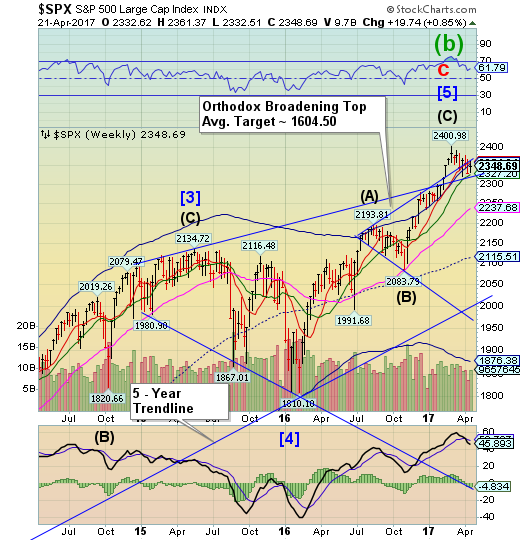
SPX bounced from its weekly Intermediate-term support at 2327.20, but was repelled by its Cycle Top resistance at 2354.64 and beneath the trendline of the Orthodox Broadening Top near 2365.00.The SPX is on an aggressive weekly sell signal.A break of Intermediate-term supportmay send the SPX to its cycle Bottom at 1876.38, or possibly lower. The MACD crossover (below) indicates a probable bearish start to the negative seasonality beginning in April.
(Bloomberg) U.S. stocks were little changed as investors assessed the French vote this weekend and after the benchmark gained as U.S. Treasury Secretary Steven Mnuchin said plans to reform taxes have progressed.
The S&P 500 lost less than 0.1 percent at 10 a.m. in New York. The benchmark rose 0.8 percent on Thursday as financial and industrial shares climbed. The Dow Jones Industrial Average added 22 points to 20,601.
NDX bounces off its trendline.
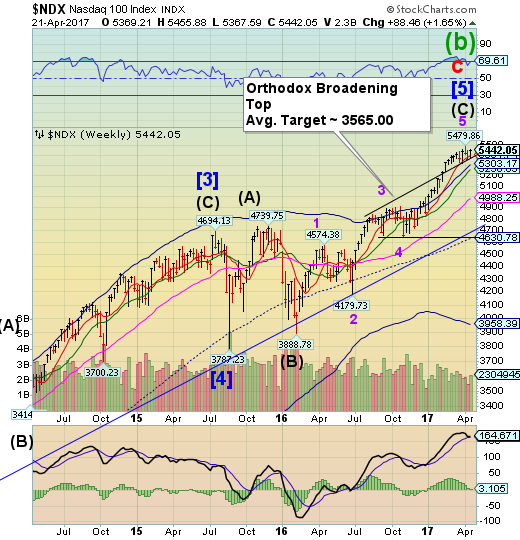
NDX bounced from Short-term Support at 5391.74 and the trendline of the Orthodox Broadening Topat 5365.00.A loss of that support may create a sell signal in the NDX with a subsequent decline testing lower supports. A decline beneath mid-Cycle support at 4630.78 may bring a potential change of trend with it.
(WolfStreet) No one knows the full magnitude, but it’s huge.
How big is margin debt really, and how much of a threat is it to the stock market and to “financial stability,” as central banks like to call their concerns about crashes? Turns out, no one really knows.
What we do know: Margin debt, as reported monthly by the New York Stock Exchange, spiked to another record high of $528 billion. But it’s only part of the total outstanding margin debt – which is when investors borrow money from their broker, pledging their portfolio as collateral.
An example of unreported margin debt: Robo-advisory Wealthfront, a so-called fintech startup overseeing nearly $6 billion, announced that it would offer its clients loans against their portfolios.
High Yield Bond Index declines beneath Intermediate-term support.

The High Yield Bond Index declined beneath Intermediate-term supportat 165.77, further confirming a sell signal.The Cycles Model suggests weakness ahead that may last the entire month of April.
(MarketRealist) Bill Gross on high-yield bonds
In the previous part of this series, we saw that Bill Gross believes the equity market is “priced for too much hope.” He also believes that all asset classes are elevated to artificial levels. For the high-yield bond market, he believes it’s “priced for too much growth.”
The high-yield bond market is generally considered risky because those bonds have lower credit ratings than other investment bonds such as Treasury bonds and corporate bonds. High-yield bonds generally pay higher and thus have higher default risks. Startups and capital-intensive companies issue high-yield bonds. Gross believes equity and other riskier assets are priced too high with expectations of growth.
TO:USB breaks out.
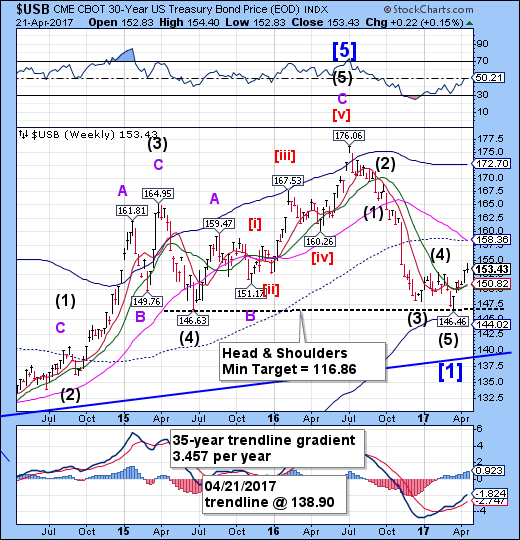
The Long Bond broke out above its prior 2017 highs andappears to be due for a Trading Cycle low next week. It may pull back to Intermediate-term support at 150.65 before resuming its rally.The Cycles Model now suggests an extended period of strength may extend through mid-May. The mid-Cycle resistance and long-term resistance at 158.36 still appears to be the target, but it may go higher.
(Reuters) U.S. Treasury debt pricesgained on Friday ahead of Sunday’s presidential election in France, with no major U.S. economic releases due to set market direction.
Benchmark 10-year note yields have held in a tight rangesince falling to five-month lows on Tuesday, as investors awaita catalyst to determine if bonds will continue their rally.
Opinion polls suggest that France’s election will likely come down to a second-round duel between independent centrist Emmanuel Macron and Marine Le Pen, head of the anti-European Union and anti-immigrant National Front.
The euro bounces at the trendline.
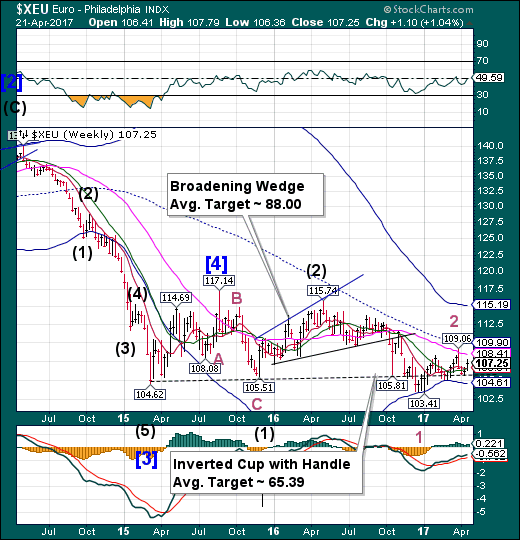
The euro bounced off the Lip of the Cup with Handle formation, but may have reversed beneath Long-term resistance at 108.41. The Cycles Model suggests that the decline may resume beneath the trendline near 105.50.
(CNBC) The euro could take a "swan dive" if the two extremist candidates advance to the second round of the French election, currency expert Boris Schlossberg told CNBC on Friday.
And right now, the race is a "complete wild card," with about 40 percent of voters undecided, he pointed out. The first round of the election is set for Sunday.
Four candidates are making a bid for the presidency. Former Economy Minister Emmanuel Macron and mainstream conservative Francois Fillon are the two centrist candidates. Far-right Marine Le Pen and far-left Jean-Luc Melenchon have both indicated they are willing to take France out of the European Union.
Euro Stoxx tests weekly short-term support.

The EuroStoxx 50 Index tested weekly Short-term support at 3421.04 after achieving Wave equality three weeks ago. A breach of Short-term support puts Stoxx on an aggressive sell signal. The signal may be confirmed as EuroStoxx declines beneath Intermediate-term support at 3370.18.
(ZeroHedge) Ahead of the first round of the French elections on Sunday, Deutsche Bank (DE:DBKGn)'s equity strategist Sebastian Raedler again reminds his bank's clients and the seemingly unperturbed markets, that despite the tightening of the poll numbers among the four front-runners, European equities show little sign of pricing in a meaningful political risk premium. In fact, as he notes below, European equities appear to not have priced in even a modest political risk discount.
This may be a mistake. As a reminder, if we look at the last 3 polls run by those pollsters then the spread between the four candidates is at an average of 4.5%. Macron’s average is 23.3%, Le Pen 22.3%, Fillon 19.7% and Melenchon 18.8%. So it’s quite possible that these 4 candidates will be clustered together given that the spread is within the margin of error from previous elections.
The yen challenges Long-term resistance.

The yen challenged Long-term resistance at 92.37 while making an inverted Trading Cycle high this week. It may be due for a pullback to Short-term support at 89.53 next week. However, the Cyclical strength may persist beyond any short-term consolidations.
(Forbes) It seems market investors are possessed by the idea of buying Japanese yen in times of crisis. Amidst the heightened tensions surrounding North Korea, the Japanese yen has been appreciating. Before April 11, the yen traded at 110 per U.S. dollar. Now it's trading at around 108.
One interpretation is that the movement is unsurprising.
Seiji Adachi, director of research at Marusan Securities Co., argues that the “equilibrium exchange rate” is around 105 per dollar based on purchasing power parity, and 115 per dollar based on the relative Japanese-American monetary base -- and one should expect movements in both directions within 15 % of the equilibrium rate.
The Nikkei bounces off mid-Cycle support.
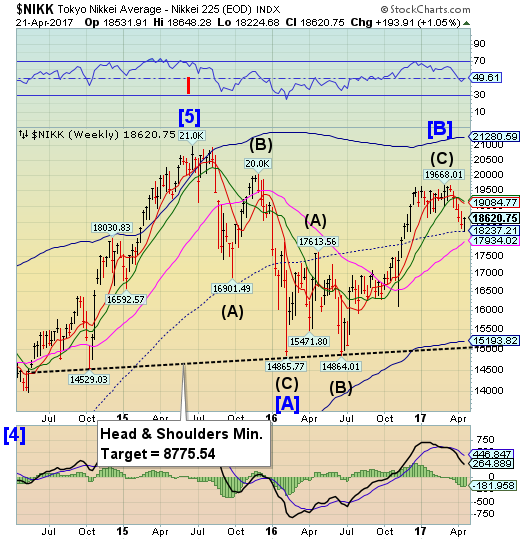
The Nikkei bounced off mid-cycle support at 19237.21 on Monday to begin a corrective phase that may last another week.The retracement target may be as high as Intermediate-term resistance at 19162.11, but may also stop at round number resistance at 19000.00. Likewise, should the yen continue to show strength, the Nikkei may test Long-term support at 17934.02 before completing its consolidation.
(BusinessTimes) Japanese stocks rose to 1-1/2 week highs on Friday as global investors bet that US tax reforms are gaining traction, but Fujifilm Holdings tumbled after delaying the release of its earnings because of an accounting probe.
The Nikkei 225 share average gained one per cent to 18,620.75, its highest closing level since April 11.
For the week, it gained 1.6 per cent, posting its first weekly gain in six weeks. 12121211
U.S. dollar bounces a second time off Long-term support.

USD bounced a second time within a month off Long-term support at 99.07. The bounce showed little strength and may be doomed to failure as a Master Cycle low may be due in the next two weeks.USD is on a sell signal that may imply broken supports ahead.
(Nasdaq) The US dollar fell for a second consecutive week as the Fed rate hike outlook continued to deteriorate . Geopolitical jitters are almost certainly a big part of that story, even if the narrative has somewhat shifted from US tensions with Russia and North Korea to EU politics. Homegrown factors have also emerged however amid growing worries about slowing economic growth.
An ominous picture is painted by the closely watched GDPNow model from the Atlanta Fed. It updates quarterly GDP growth projections with each incoming bit of relevant economic data. That forecast now predicts that output will add just 0.5 percent in the three months to March. That is far weaker than the 1-2 percent range expected by the markets.
Gold overshoots targets, may be ready to decline.

Gold overshot its Orthodox Broadening Top retracement target in a Trading Cycle inversion, but now may be ready to decline.The overshoot took the form of a Broadening Wedge with a probable downside target of 1000.00. Both the Cycles Model and Orthodox Broadening Top pattern anticipate the decline to resume with only short-term bounces until it reaches its next Master Cycle low due in mid-May.
(MarketWatch) Gold prices climbed on Friday, erasing a weekly loss to post a modest gain of less than 0.1% for the week. Prices got a boost from uncertainty ahead of France's presidential election, as well as from weakness in the U.S. stock market. June gold GCM7, +0.17% rose $5.30, or 0.4%, to settle at $1,289.10 an ounce. It settled at $1,288.50 at the end of last week's trading.
Crude declines to Long-term support.

Crude declined to Long-term support at 49.12 to make a probable Master Cycle low this week. If so, it may retest Intermediate-term resistance at 52.16 again. However, corrections may also extend in the direction of the immediate trend, suggesting that the Head & Shoulders neckline near 48.00 may also be probed before a pullback
(Reuters) Oil prices tumbled more than 2 percent on Friday, notching the biggest weekly decline in more than a month on mounting evidence that U.S. production and inventory growth were offsetting OPEC's attempts to reduce the global crude glut.
Brent futures LCOc1 settled at $51.96 a barrel, down $1.03, or 2 percent at the market's close. U.S. crude futures CLc1 ended at $49.62 a barrel, down 2.2 percent, or $1.09.
Volumes were heavy, with more than 665,000 WTI futures changing hands, surpassing the daily average of 525,000 contracts.
Shanghai Index crosses the trendline.
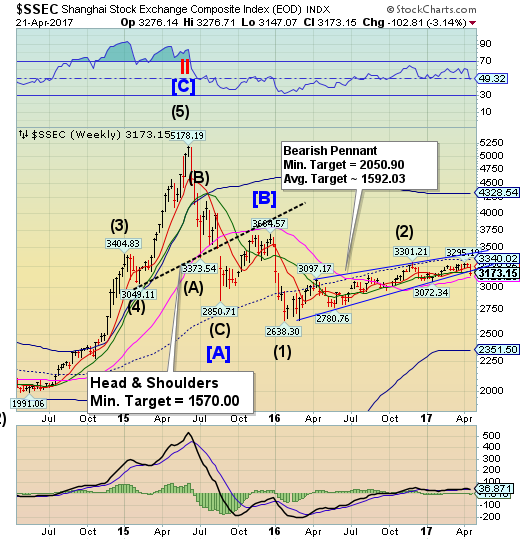
The Shanghai Index finally crossed its 15-month-old trendline at 3240.00. It also violated Intermediate-term support at 3196.57, confirming a sell signal. The decline may persist through mid-May when a Trading Cycle low is possible.
(ZeroHedge) The pressure point in Asian stock markets this week has been the decline in Chinese equities (the biggest weekly drop in 4 months).
Despite a stellar performance of the economy the outlook for the Shanghai Composite Index isn’t promising as the government is taking advantage of better growth to spur deleveraging.
For a market relying more on liquidity than fundamentals, China’s worsening monetary conditions index suggests tough times ahead...
As a reminder, the Shanghai Composite Index, notorious for its wild swings over the past two years, has gone 86 trading days without a loss of more than 1% on a closing basis, the longest stretch since the market’s infancy in 1992.
The Banking Index forming the right shoulder.
--BKX appears to be finishing the right shoulder of a Head & Shoulders formation. The sell signal remains in place with a probable new target near mid-Cycle support at 75.38. Serious investors may be well served to sell any rally rather than buy the dip, as the decline may resume next week.
(NYTimes) Two top bankers can’t agree on whether lenders are too big to fail.
The boss of JPMorgan Chase (NYSE:JPM), Jamie Dimon, reckons the problem is solved. The Fed banker Neel Kashkari disagrees, because using debt to absorb losses is flawed. Markets suggest Mr. Dimon is closer to the mark.
(OilPrice) Last week, U.S. banks boosted the borrowing bases for several independent energy companies, lifting spirits in the industry. The move was taken as a sign that lenders are beginning to share in the optimism that oil and gas producers have been enjoying since the beginning of the year, with prices staying above $50.
While some banks seem to be sharing some of the optimism, others are more cautious. A recent analysis from Bloomberg Gadfly’s Lisa Abramowicz reveals that a lot of energy companies with revolving credit lines are tapping deep into these resources. Abramowicz cites data from Bloomberg Intelligence that shows at least 11 companies have used up more than two-thirds of their credit lines.
(ZeroHedge) Another day, another fine for the bank that no matter what, just can't play by the rules.
On Thursday, the Federal Reserve fined Deutsche Bank $156.6 million for violating foreign exchange rules and running afoul of the Volcker Rule, suggesting it was likely trading FX out of its own account in violation of Dodd-Frank.
In levying the FX fine on Deutsche Bank, the Fed said it found "deficiencies in the firm's oversight of, and internal controls over, FX traders who buy and sell U.S. dollars and foreign currencies for the organization's own accounts and for customers."
Additionally, and stunningly, years after it became clear that FX chat rooms are about the worst possible idea for currency traders, the Fed said Deutsche Bank failed to detect and address that its traders were still "using electronic chatrooms to communicate with competitors about their trading positions." The order requires Deutsche Bank to improve its senior management oversight and controls relating to the firm's FX trading.
(ZeroHedge) Literally no one knows the true 'value' of research, not even the investment banks that are selling it. Up until now, equity research has been treated as a 'freebie' given away to institutional clients in return for trading commissions but that is all about to change thanks to the European Union’s MiFID II regulations, which require asset managers to separate trading commissions from investment-research payments.
Unfortunately, at least for the Investment Banks of the world, while the cost of generating equity research may be substantial, it turns out that the true 'value', as defined by institutional clients' maximum willingness to pay for reports, may be much less. Which is shocking given the creativity required to constantly generate new variations of daily reports politely suggesting that you "Buy The F---ing Dip."
